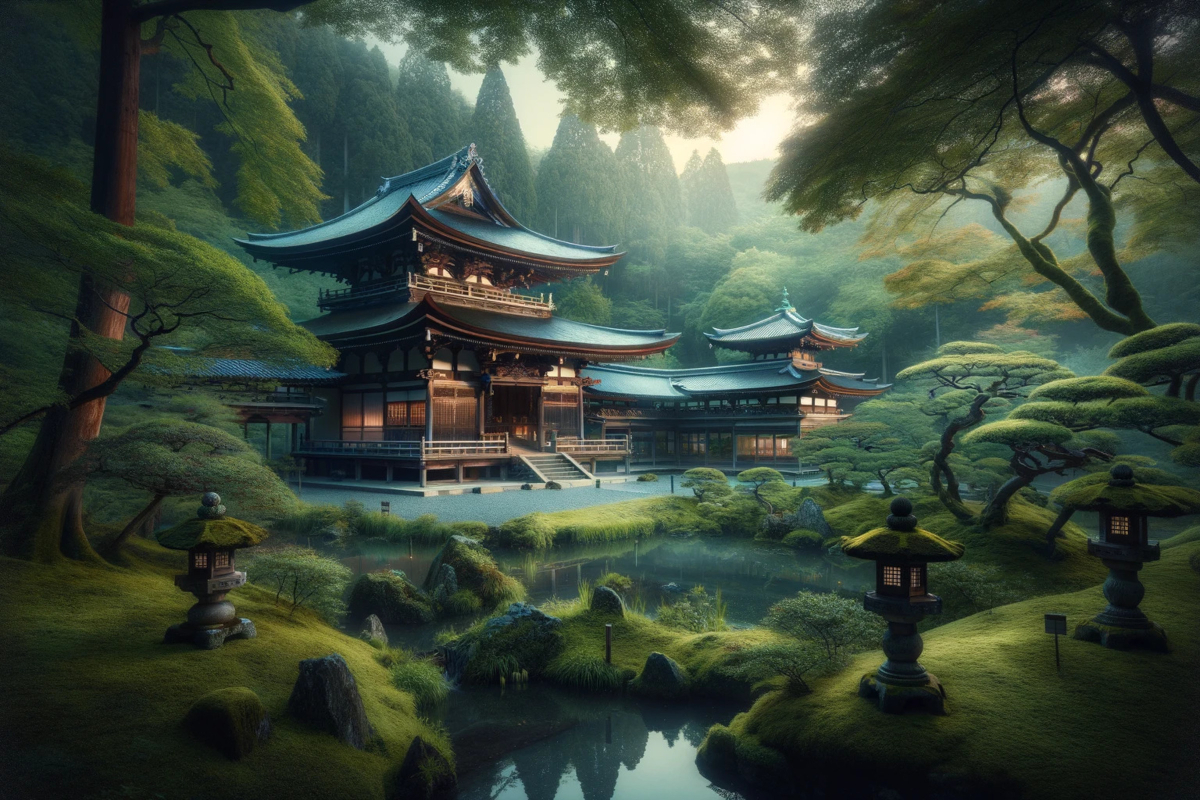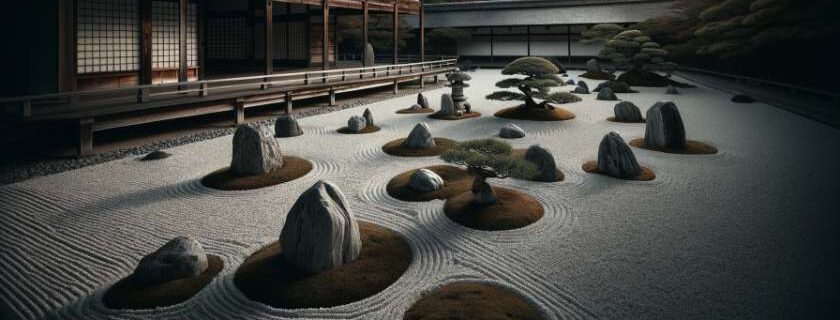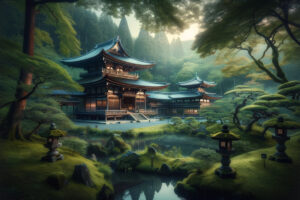
Discover a serene journey through Kyoto’s ancient temples, each holding tales of history and spirituality. From the majestic Kinkaku-ji to the tranquil Ryoan-ji, these sacred sites offer a glimpse into Japan’s rich cultural heritage. Dive into a world where tradition meets tranquility as we explore the hidden gems nestled amidst Kyoto’s lush landscapes.
Prepare to be captivated by the allure of these architectural marvels and immerse yourself in their peaceful ambiance. Join us on this virtual tour as we unveil the enchanting beauty and profound significance of Kyoto temples that continue to mesmerize visitors from around the globe.
- Key Takeaways
- 10 Majestic Kyoto Temples
- 1. Kinkaku-ji (The Golden Pavilion)
- 2. Fushimi Inari Taisha
- 3. Ginkaku-ji (The Silver Pavilion)
- 4. Kiyomizu-dera
- 5. Ryoan-ji (Famous for its Zen rock garden)
- 6. Tofuku-ji (Renowned for its autumn foliage)
- 7. Eikando Zenrin-ji (Famous for its fall colors and the statue of Mikaeri Amida)
- 8. Sanjusangen-do (Known for its 1001 statues of Kannon)
- 9. Nanzen-ji (Famous for its Zen gardens and aqueduct)
- 10. Tenryu-ji (Known for its beautiful garden and Arashiyama bamboo grove nearby)
- Summary
- Frequently Asked Questions
Key Takeaways
- Explore the iconic Kyoto temples like Kinkaku-ji, Fushimi Inari Taisha, Ginkaku-ji, and more to immerse yourself in Japan’s rich cultural heritage.
- Discover the serene beauty of Zen gardens at Ryoan-ji and Nanzen-ji, offering a peaceful retreat from the bustling city life.
- Witness the vibrant autumn foliage at Tofuku-ji and Eikando Zenrin-ji, creating a picturesque landscape during the fall season.
- Marvel at the intricate statues and architecture at Sanjusangen-do, showcasing the artistic and spiritual essence of Japanese Buddhism.
- Don’t miss the enchanting natural landscapes at Tenryu-ji, with its beautiful garden and the nearby Arashiyama bamboo grove.
- Immerse yourself in the spiritual and historical significance of Kyoto’s temples, each offering a unique glimpse into Japan’s past and traditions.
10 Majestic Kyoto Temples

1. Kinkaku-ji (The Golden Pavilion)
Kinkaku-ji, also known as the Golden Pavilion, is a stunning Zen Buddhist temple[1] coated in gold leaf that dates back to the 14th century. Originally constructed as a retirement villa for a shogun, this architectural masterpiece exudes tranquility and elegance.
Situated by a peaceful pond, Kinkaku-ji offers mesmerizing reflections on the water’s surface, creating an ethereal ambiance that captivates visitors. The temple’s design harmoniously blends with its natural surroundings, making it a picturesque and serene site to explore.
Visitors can marvel at the intricate details of this historic building while strolling along scenic paths adorned with plum trees and lush greenery. The Golden Pavilion stands out not only for its aesthetic beauty but also for its cultural significance as a symbol of peace and harmony.
Admission fees are reasonable considering the unparalleled views and historical value offered by Kinkaku-ji. A visit to this iconic temple in Kyoto’s western region is a must-do experience that promises both visual delight and spiritual enrichment.
2. Fushimi Inari Taisha
Famous for its thousands of vibrant red torii gates, Fushimi Inari Taisha is a visual spectacle that captivates visitors with its striking beauty and cultural significance. These gates symbolize the transition from the mundane to the sacred, creating a mesmerizing path through the shrine grounds.
Dedicated to Inari, the Shinto god of rice and prosperity, this shrine holds deep-rooted spiritual importance for many Japanese people who visit to pray for good fortune and success in their endeavors. The connection to agriculture and abundance makes it a revered destination during harvest seasons.
Perched atop a mountain, Fushimi Inari Taisha offers breathtaking panoramic views of Kyoto city below. The hiking journey up through the torii gates provides not only an immersive cultural experience but also rewards hikers with stunning vistas that showcase Kyoto’s charm from a unique perspective.
Visiting this iconic site allows travelers to delve into Japan’s rich history, immerse themselves in traditional Shinto practices, and witness firsthand the fusion of natural beauty with spiritual reverence that defines many aspects of Japanese culture.
3. Ginkaku-ji (The Silver Pavilion)
Ginkaku-ji, known for its silver appearance, actually lacks real silver coating but shines with elegance nonetheless. The temple boasts a stunning moss garden that captivates visitors with its serene beauty.
One of the highlights of Ginkaku-ji is the sand cone meticulously crafted to resemble Mount Fuji. This symbolic representation adds depth to the visitor’s experience, enhancing the spiritual ambiance of the temple grounds.
Designed as a place for contemplation and tranquility, Ginkaku-ji offers a peaceful retreat from the bustling city life of Kyoto. Visitors can immerse themselves in meditation while admiring the intricate architecture and natural surroundings.
With its unique features and serene atmosphere, Ginkaku-ji stands out as a must-visit destination for those seeking solace and spiritual rejuvenation amidst Japan’s rich cultural heritage.
4. Kiyomizu-dera
Kiyomizu-dera is a remarkable wooden temple in Kyoto known for its vast veranda offering breathtaking panoramic views of the city. This awe-inspiring structure was constructed entirely without nails, showcasing the intricate traditional Japanese building techniques that have stood the test of time.
Visitors to Kiyomizu-dera can partake in a unique ritual at the Otawa Waterfall located on the temple grounds. Here, individuals drink from three streams believed to confer health, longevity, and success in studies. The act of sipping this sacred water symbolizes gaining good fortune and blessings.
This ancient temple’s history dates back over 1,200 years when it was founded during the early Heian period. Its enduring popularity among locals and tourists alike underscores its significance as a spiritual sanctuary steeped in Buddhist traditions.
The serene ambiance surrounding Kiyomizu-dera invites contemplation and reflection amidst nature’s beauty while providing insight into Japan’s rich cultural heritage preserved within its walls.

5. Ryoan-ji (Famous for its Zen rock garden)
Ryoan-ji is a Zen temple celebrated for its simple yet profound rock garden design. The garden features precisely positioned rocks on a bed of immaculate white gravel, creating a serene and contemplative atmosphere.
Visitors are encouraged to sit quietly and meditate upon the arrangement of the rocks, with interpretations varying from depictions of islands in a sea to symbolic representations of mountains emerging through clouds. This open-ended nature allows individuals to find their own meaning and experience inner peace in this tranquil setting.
The layout of the rock garden at Ryoan-ji is not merely decorative but serves as an essential element in Zen philosophy, emphasizing harmony, balance, and simplicity. Each rock’s placement is meticulously considered to evoke feelings of stillness and mindfulness within those who observe it.
This unique feature sets Ryoan-ji apart as a place where visitors can engage with nature in a deeply introspective way, appreciating the beauty that arises from minimalism and thoughtful design. The rock garden stands as an enduring symbol of tranquility amidst the bustling world outside its walls.
6. Tofuku-ji (Renowned for its autumn foliage)
Tofuku-ji stands out as one of Kyoto’s prime locations to witness the stunning colors of fall. The temple boasts a captivating wooden bridge enveloped by vibrant maple trees that create a mesmerizing scene during autumn.
Visitors flock to Tofuku-ji specifically to experience the breathtaking views offered by the rich array of fall foliage. The hues of red, orange, and yellow paint a picturesque landscape that is truly awe-inspiring for all who visit this iconic spot in Kyoto.
7. Eikando Zenrin-ji (Famous for its fall colors and the statue of Mikaeri Amida)
Eikando Zenrin-ji temple is renowned for its breathtaking autumn foliage, particularly the vibrant maple trees that adorn its grounds. Visitors are treated to a mesmerizing display of reds, oranges, and yellows during the fall season.
The highlight of Eikando Zenrin-ji is the revered statue of Mikaeri Amida, also known as the “Looking Back Buddha.” This iconic statue symbolizes reflection and mindfulness, adding a profound spiritual dimension to the temple’s ambiance.
Stepping into Eikando Zenrin-ji offers a tranquil sanctuary ideal for meditation and contemplation. The peaceful surroundings and meticulously maintained gardens create an atmosphere conducive to inner peace and self-discovery.
8. Sanjusangen-do (Known for its 1001 statues of Kannon)
Sanjusangen-do is renowned for housing 1001 life-sized statues of the Buddhist deity Kannon, each uniquely crafted to portray different facets of compassion and mercy. This temple stands out not only for the sheer number of statues but also for their intricate details that showcase various forms and expressions.
The Guinness World Record recognizes Sanjusangen-do as the site with the most statues in one location, drawing visitors from around the globe to witness this remarkable display of artistry and spirituality. The century-old history behind these statues adds a layer of cultural significance to this iconic temple, making it a must-visit destination in Kyoto.
Visitors can marvel at the precision and craftsmanship involved in creating these statues, each telling a story through its elaborate design and symbolism. The experience at Sanjusangen-do goes beyond mere sightseeing; it offers a glimpse into Japan’s rich religious heritage and artistic traditions.
For those seeking not just beauty but also spiritual enlightenment, Sanjusangen-do provides a serene setting where one can reflect on the essence of compassion embodied by Kannon’s myriad forms. This temple serves as a testament to both human creativity and devotion throughout centuries, encapsulating the essence of Japanese culture within its sacred walls.
9. Nanzen-ji (Famous for its Zen gardens and aqueduct)
Nanzen-ji captivates visitors with its meticulously raked gravel patterns in the serene Zen gardens, offering a tranquil space to contemplate and unwind amidst nature’s beauty. The brick aqueduct at Nanzen-ji stands as a testament to Kyoto’s advanced water management system, symbolizing the city’s rich history and ingenuity.
The Zen gardens of Nanzen-ji provide a peaceful retreat from the hustle and bustle of urban life, inviting individuals to immerse themselves in quiet contemplation while admiring the artistry of the garden design. The aqueduct at Nanzen-ji showcases Kyoto’s deep connection with water conservation practices and highlights how historical structures like these have shaped modern-day infrastructure.
Visitors can stroll through this temple complex, appreciating not only its architectural marvels but also gaining insight into Japan’s cultural heritage. The harmonious blend of natural elements and man-made features at Nanzen-ji offers a profound experience that resonates with those seeking tranquility amid bustling city life.
10. Tenryu-ji (Known for its beautiful garden and Arashiyama bamboo grove nearby)
Tenryu-ji is a UNESCO World Heritage site celebrated for its exceptional garden design, offering visitors a glimpse into traditional Japanese landscaping techniques. The temple grounds are meticulously maintained, creating an atmosphere of tranquility and harmony with nature.
Adjacent to Tenryu-ji lies the famous Arashiyama bamboo grove, known for its towering bamboo stalks that create a magical ambiance. A short walk from the temple leads you to this enchanting natural wonder, making it convenient for those looking to explore both sites in one day trip.
Visitors can partake in tea ceremonies within the temple premises, immersing themselves in Japanese cultural practices while surrounded by picturesque scenery. Tenryu-ji’s location near the bamboo grove provides a serene setting where one can appreciate the beauty of nature and find inner peace amidst lush greenery.
With its harmonious blend of architecture and nature, Tenryu-ji offers a unique experience that showcases Japan’s rich cultural heritage while inviting guests to connect with their surroundings on a deeper level.

Summary
You’ve now uncovered a treasure trove of Kyoto’s most enchanting temples, from the iconic Golden Pavilion to the serene Zen gardens at Nanzen-ji. Each temple holds a unique story and beauty waiting to be explored, offering a glimpse into Japan’s rich cultural heritage. Whether you seek spiritual enlightenment, historical marvels, or simply a peaceful retreat, Kyoto’s temples have something for everyone.
So, pack your curiosity and embark on a journey through these sacred sites. Let the tranquility of the gardens and the whispers of ancient rituals guide you. Discover the harmony between nature and architecture, history and modernity. Let Kyoto’s temples be not just a destination but a transformative experience that lingers in your heart long after you’ve left.
Frequently Asked Questions
What is the significance of Kinkaku-ji (The Golden Pavilion)?
Kinkaku-ji, also known as The Golden Pavilion, holds historical importance as a Zen Buddhist temple showcasing stunning architecture covered in gold leaf. It symbolizes harmony between nature and human creations.
How can I best experience the beauty of Fushimi Inari Taisha?
To fully appreciate Fushimi Inari Taisha, explore its iconic torii gates early in the morning or late afternoon to avoid crowds. Venture beyond the main path for a more serene experience amidst nature.
Why is Ryoan-ji famous for its Zen rock garden?
Ryoan-ji’s Zen rock garden is renowned for its simplicity and tranquility, inviting visitors to contemplate life’s mysteries in a peaceful setting. The arrangement of rocks and raked gravel encourages mindfulness and reflection.
What makes Tofuku-ji unique during autumn foliage season?
Tofuku-ji stands out during autumn with vibrant foliage adorning its surroundings, creating a picturesque landscape that attracts visitors seeking breathtaking views of nature’s colorful transformation.
Why visit Sanjusangen-do with 1001 statues of Kannon?
Sanjusangen-do impresses with its awe-inspiring display of 1001 statues depicting Kannon, the Buddhist goddess of mercy. Each statue carries intricate details and symbolism, offering a profound spiritual experience to visitors.




